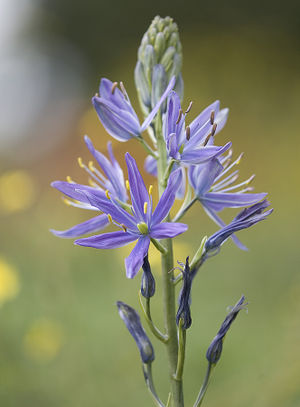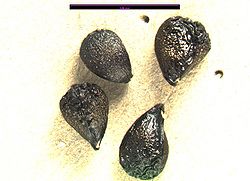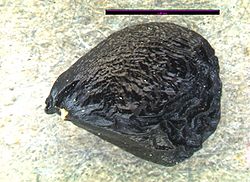Difference between revisions of "Camassia leichtlinii"
(→Taxonomy) |
(→Description) (Tag: VisualEditor) |
||
| (9 intermediate revisions by the same user not shown) | |||
| Line 1: | Line 1: | ||
| − | * | + | * Scientific Name: ''Camassia'' ''leichtlinii'' |
* Family: Asparagaceae | * Family: Asparagaceae | ||
* Common Names: great camas, large camas | * Common Names: great camas, large camas | ||
* Codon: CAMLEI | * Codon: CAMLEI | ||
| − | + | ---- | |
| − | == Taxonomy == | + | [[File:CALEI.jpg |thumb|Photo by Rod Gilbert, 2005. Also featured on Main Page]] |
| + | === Taxonomy === | ||
{{Taxobox | {{Taxobox | ||
| − | | name = | + | | name = |
| + | | image = | ||
| image_alt = Camassia leichtlinii | | image_alt = Camassia leichtlinii | ||
| image_caption = Photo by Rod Gilbert, 2005. Also featured on Main Page | | image_caption = Photo by Rod Gilbert, 2005. Also featured on Main Page | ||
| Line 22: | Line 24: | ||
| synonyms = | | synonyms = | ||
}} | }} | ||
| + | <ref>Integrated Taxonomic Information System. Retrieved from https://www.itis.gov/servlet/SingleRpt/SingleRpt?search_topic=TSN&search_value=42880</ref> | ||
| − | ==Description== | + | ===Description=== |
| − | + | Scapose perennial herb growing from a bulb, up to 5 dm tall.<ref name=":0">WTU | |
| − | + | Herbarium, Burke Museum, & University of Washington. Retrieved from http://biology.burke.washington.edu/herbarium/imagecollection/taxon.php?Taxon=Camassia%20leichtlinii</ref> Leaves basal, linear, 3-9, up to 60 cm long.<ref>Flora of North America. Retrieved | |
| − | + | from http://dev.floranorthamerica.org/Camassia_leichtlinii</ref> Inflorescences racemose, to 20 cm long.<ref>Bowcutt, F., & Hamman, S. (2016). ''Vascular Plants of the South Sound Prairies''. p. 117.</ref> Flowers radially symmetrical; tepals 6, bluish purple, evenly distributed; stamens 6, yellow; pistil 3-carpellate with superior ovary, slender style and 3 stigmas.<ref name=":3">Hitchcock, C. L., Cronquist, A., Giblin, D., | |
| − | + | & Legler, B. et al. (2018). ''Flora of the Pacific Northwest: an'' | |
| + | illustrated manual''. Seattle: University of Washington Press. p. 705.''</ref> Tepals twisting together to covary ovary when withering.<ref name=":3" /> Capsule 3-celled, 15-25 mm.<ref name=":0" /> | ||
| − | ==Bloom Period== | + | ===Bloom Period=== |
| − | April - May | + | April - May<ref name=":0" /> |
| − | ==Habitat== | + | ===Habitat=== |
| − | + | Prairies, seasonally moist, lowland meadows<ref>(Douglas et al., 2001).</ref> Prefers nitrogen rich, heavy loam mixes, but tolerates other soil types.<ref>(Klinka et al., 1989).</ref> | |
| − | + | ||
| − | + | ||
| − | + | ||
| − | + | ||
| − | + | ||
| − | + | ||
| − | + | ||
| − | ==Distribution== | + | ===Distribution=== |
| − | West of the Cascades, British Columbia to California. | + | West of the Cascades, British Columbia to California.<ref name=":0" /> |
| − | ==Uses== | + | ===Uses=== |
Wildlife-Bees use this plant | Wildlife-Bees use this plant | ||
| − | Landscaping-A very ornamental plant<ref>USDA.gov</ref>, there are many named varieties. Use in meadows, grassy slopes and banks. Showy bloom with attractive seed heads. Very tough plant for exposed, hot dry sites once established (S. Bastin, personal communication). Use in containers or along pond edges (B. Costanzo, personal communication). | + | Landscaping-A very ornamental plant<ref name=":1">USDA.gov</ref>, there are many named varieties. Use in meadows, grassy slopes and banks. Showy bloom with attractive seed heads. Very tough plant for exposed, hot dry sites once established (S. Bastin, personal communication). Use in containers or along pond edges (B. Costanzo, personal communication). |
| − | First Nation-the bulb is about 3cm in diameter and can be eaten raw or cooked. It is a good substitute for a potatoe. The cooked bulb can also be dried for later use or ground into a powder and used as a thickener in soups or as an additive to cereal flours when making bread, cakes etc. The bulbs can be boiled down to make a molasses, this was used on festival occasions by various Indian tribes. One report says that the bulbs contain inulin (a starch that cannot be digested by humans) but that this breaks down when the bulb is cooked slowly to form the sugar fructose which is sweet and easily digested. | + | First Nation-the bulb is about 3cm in diameter and can be eaten raw or cooked. It is a good substitute for a potatoe. The cooked bulb can also be dried for later use or ground into a powder and used as a thickener in soups or as an additive to cereal flours when making bread, cakes etc. The bulbs can be boiled down to make a molasses, this was used on festival occasions by various Indian tribes. One report says that the bulbs contain inulin (a starch that cannot be digested by humans) but that this breaks down when the bulb is cooked slowly to form the sugar fructose which is sweet and easily digested.<ref>Turner. N. J. (1995). ''Food Plants of Coastal First Peoples.'' Vancouver: UBC Press.</ref> |
| − | Other-This species can be confused with certain poisonous bulbs in the genus Zigadenus | + | Other-This species can be confused with certain poisonous bulbs in the genus Zigadenus.<ref name=":1" /> |
| − | ==Propagation== | + | ===Propagation=== |
| − | A very easily grown plant, it succeeds in almost any soil and is tolerant of considerable neglect once it is established. Plants often self-sow. Plants can be naturalized in damp grass, this should not be trimmed until mid to late summer when the bulbs have flowered and the leaves have died down. Plant the bulbs 7 - 10cm deep in early autumn and then leave undisturbed. The bulbs should be planted about 20cm deep. | + | A very easily grown plant, it succeeds in almost any soil and is tolerant of considerable neglect once it is established. Plants often self-sow. Plants can be naturalized in damp grass, this should not be trimmed until mid to late summer when the bulbs have flowered and the leaves have died down. Plant the bulbs 7 - 10cm deep in early autumn and then leave undisturbed. The bulbs should be planted about 20cm deep.<ref name=":2">Plants for a Future. Retrieved from https://pfaf.org/user/Plant.aspx?LatinName=Camassia+leichtlinii</ref> |
| − | Seeds are best sown as soon as they are ripe in a cold frame and can also be sown in a cold frame in spring. It usually germinates in 1 - 6 months at 15°c, but it can be erratic. Sow the seed thinly so that it does not need to be thinned and allow the seedlings to grow on undisturbed for their first year. Give an occasional liquid feed to ensure that the plants do not become nutrient deficient. | + | Seeds are best sown as soon as they are ripe in a cold frame and can also be sown in a cold frame in spring. It usually germinates in 1 - 6 months at 15°c, but it can be erratic. Sow the seed thinly so that it does not need to be thinned and allow the seedlings to grow on undisturbed for their first year. Give an occasional liquid feed to ensure that the plants do not become nutrient deficient.<ref name=":2" /> |
Seed Storage-Store in a cool, dry place. | Seed Storage-Store in a cool, dry place. | ||
| Line 59: | Line 56: | ||
Fruit/Seed Dormancy and Treatment-then the plants are dormant in late summer, pot up the small bulbs putting 2 - 3 bulbs in each pot. Grow them on for another one or two years in a cold frame before planting them out when dormant in late summer. Offsets in late summer. The bulb has to be scored in order to produce offsets. | Fruit/Seed Dormancy and Treatment-then the plants are dormant in late summer, pot up the small bulbs putting 2 - 3 bulbs in each pot. Grow them on for another one or two years in a cold frame before planting them out when dormant in late summer. Offsets in late summer. The bulb has to be scored in order to produce offsets. | ||
| − | + | [[File:Camassia leichtlimii.jpg|250px|thumb|''Camassia leichtlinii,'' photo Lisa Hintz]] | |
===Seed=== | ===Seed=== | ||
'''Seed sample from:''' 2011 | '''Seed sample from:''' 2011 | ||
| Line 79: | Line 76: | ||
'''Longitudinal Cross Section:''' obovate [[File:Calei-obovate.png]] | '''Longitudinal Cross Section:''' obovate [[File:Calei-obovate.png]] | ||
| − | + | ||
[[File:Camassia leichtlinii single.jpg|250px|thumb|''Camassia leichtlinii'', photo Lisa Hintz]] | [[File:Camassia leichtlinii single.jpg|250px|thumb|''Camassia leichtlinii'', photo Lisa Hintz]] | ||
| Line 85: | Line 82: | ||
{{Basics}} | {{Basics}} | ||
| − | ==Photo Gallery== | + | ===Photo Gallery=== |
<gallery> | <gallery> | ||
File:CAMLEI4.jpg|Photo courteys of CNLM | File:CAMLEI4.jpg|Photo courteys of CNLM | ||
| Line 92: | Line 89: | ||
</gallery> | </gallery> | ||
| − | == | + | ===References=== |
<references /> | <references /> | ||
Latest revision as of 10:20, 25 June 2021
- Scientific Name: Camassia leichtlinii
- Family: Asparagaceae
- Common Names: great camas, large camas
- Codon: CAMLEI
Contents
Taxonomy
| Scientific classification | |
|---|---|
| Kingdom: | Plantae |
| Subkingdom: | Viridiplantae |
| Phylum: | Tracheophyta |
| Subphylum: | Spermatophytina |
| Class: | Magnoliopsida |
| Order: | Asparagales |
| Family: | Asparagaceae |
| Genus: | Camassia Lindl. |
| Species: | Camassia leichtlinii (Baker) S. Watson |
Description
Scapose perennial herb growing from a bulb, up to 5 dm tall.[2] Leaves basal, linear, 3-9, up to 60 cm long.[3] Inflorescences racemose, to 20 cm long.[4] Flowers radially symmetrical; tepals 6, bluish purple, evenly distributed; stamens 6, yellow; pistil 3-carpellate with superior ovary, slender style and 3 stigmas.[5] Tepals twisting together to covary ovary when withering.[5] Capsule 3-celled, 15-25 mm.[2]
Bloom Period
April - May[2]
Habitat
Prairies, seasonally moist, lowland meadows[6] Prefers nitrogen rich, heavy loam mixes, but tolerates other soil types.[7]
Distribution
West of the Cascades, British Columbia to California.[2]
Uses
Wildlife-Bees use this plant Landscaping-A very ornamental plant[8], there are many named varieties. Use in meadows, grassy slopes and banks. Showy bloom with attractive seed heads. Very tough plant for exposed, hot dry sites once established (S. Bastin, personal communication). Use in containers or along pond edges (B. Costanzo, personal communication). First Nation-the bulb is about 3cm in diameter and can be eaten raw or cooked. It is a good substitute for a potatoe. The cooked bulb can also be dried for later use or ground into a powder and used as a thickener in soups or as an additive to cereal flours when making bread, cakes etc. The bulbs can be boiled down to make a molasses, this was used on festival occasions by various Indian tribes. One report says that the bulbs contain inulin (a starch that cannot be digested by humans) but that this breaks down when the bulb is cooked slowly to form the sugar fructose which is sweet and easily digested.[9] Other-This species can be confused with certain poisonous bulbs in the genus Zigadenus.[8]
Propagation
A very easily grown plant, it succeeds in almost any soil and is tolerant of considerable neglect once it is established. Plants often self-sow. Plants can be naturalized in damp grass, this should not be trimmed until mid to late summer when the bulbs have flowered and the leaves have died down. Plant the bulbs 7 - 10cm deep in early autumn and then leave undisturbed. The bulbs should be planted about 20cm deep.[10]
Seeds are best sown as soon as they are ripe in a cold frame and can also be sown in a cold frame in spring. It usually germinates in 1 - 6 months at 15°c, but it can be erratic. Sow the seed thinly so that it does not need to be thinned and allow the seedlings to grow on undisturbed for their first year. Give an occasional liquid feed to ensure that the plants do not become nutrient deficient.[10]
Seed Storage-Store in a cool, dry place.
Fruit/Seed Dormancy and Treatment-then the plants are dormant in late summer, pot up the small bulbs putting 2 - 3 bulbs in each pot. Grow them on for another one or two years in a cold frame before planting them out when dormant in late summer. Offsets in late summer. The bulb has to be scored in order to produce offsets.
Seed
Seed sample from: 2011
Average Measurement: 3.3 x 2.2 x 2.1
Measurement Range: L: 3 - 3.75, W: 2 - 2.5, D: 1.75 - 2.25
Features
Shape: Seed are narrower at hilum end, rounding off at opposite side. Hilum end ranges from tapered to pointy in shape.
Color: Seeds black, with conspicuous white hilum.
Surface: A wrinkled seam runs from hilum down the length of the seed in most. Seed is glossy, and wrinkled or bumpy.
Latitudinal Cross Section: elliptical ![]()
Longitudinal Cross Section: obovate ![]()
Basic Explanations and Assumptions:
The dimensions for the seeds are length x width x depth. The location of the hilum is used as the base of the seed, and the length is measured from hilum to the opposite apex. Where a style is present, the length is measured from the hilum to the bottom of the style. Width is measured at a right angle to the length at the widest part. Depth is measured at a right angle to the intersection of height and width lines.
Measurements included are the mean average for each measurement of ten separate seeds.
All measurements in millimeters unless otherwise noted.
Photo Gallery
References
- ↑ Integrated Taxonomic Information System. Retrieved from https://www.itis.gov/servlet/SingleRpt/SingleRpt?search_topic=TSN&search_value=42880
- ↑ 2.0 2.1 2.2 2.3 WTU Herbarium, Burke Museum, & University of Washington. Retrieved from http://biology.burke.washington.edu/herbarium/imagecollection/taxon.php?Taxon=Camassia%20leichtlinii
- ↑ Flora of North America. Retrieved from http://dev.floranorthamerica.org/Camassia_leichtlinii
- ↑ Bowcutt, F., & Hamman, S. (2016). Vascular Plants of the South Sound Prairies. p. 117.
- ↑ 5.0 5.1 Hitchcock, C. L., Cronquist, A., Giblin, D., & Legler, B. et al. (2018). Flora of the Pacific Northwest: an illustrated manual. Seattle: University of Washington Press. p. 705.
- ↑ (Douglas et al., 2001).
- ↑ (Klinka et al., 1989).
- ↑ 8.0 8.1 USDA.gov
- ↑ Turner. N. J. (1995). Food Plants of Coastal First Peoples. Vancouver: UBC Press.
- ↑ 10.0 10.1 Plants for a Future. Retrieved from https://pfaf.org/user/Plant.aspx?LatinName=Camassia+leichtlinii






